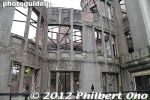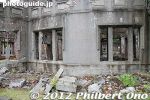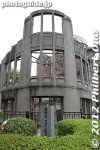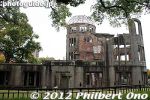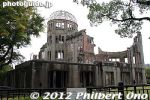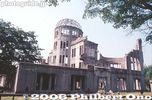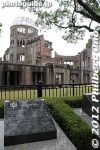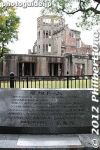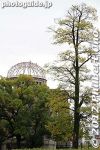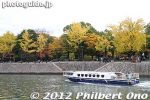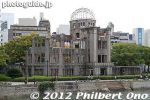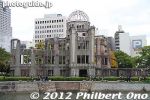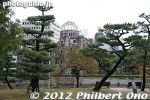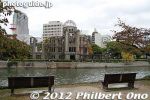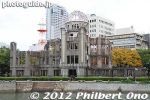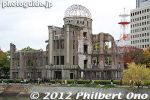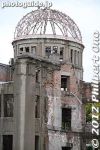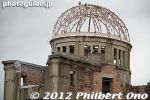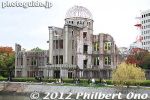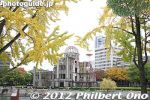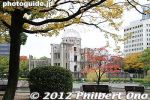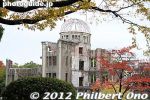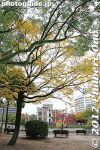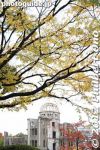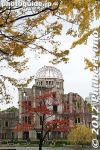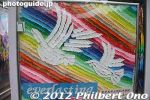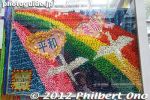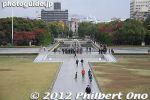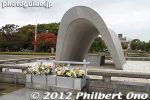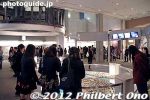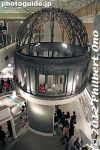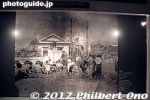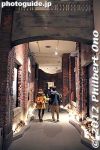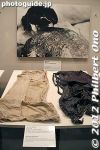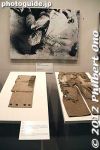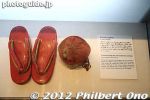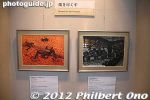 Image search results - "atomic" Image search results - "atomic" |
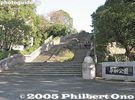
Entrance to the Peace Park
|
|

Peace Fountain with the Peace Statue in the distanceA fountain of water was made for the victims who were desperate for water.
|
|
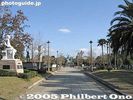
Path to Peace Statue
|
|
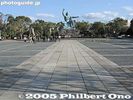
Peace StatueEvery Aug. 9, the anniversary of the atomic bombing, a memorial service is held here.
|
|
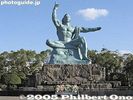
Peace StatueSculptor was Seibo Kitamura.
|
|

The Peace Statue was built in Aug. 1955, the 10th anniversary of the bombing. The Peace Statue was modeled after popular wrestler Rikidozan.
|
|

The folded right leg symbolizes quiet meditation.
|
|

The right hand points to the threat of nuclear weapons.The bronze statue is 10 meters tall.
|
|
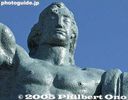
The closed eyes express a prayer for all war victims.
|
|
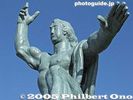
The outstretched left hand symbolizes tranquility and world peace.
|
|
|
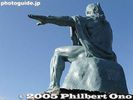
The left leg is poised for action to assist humanity.
|
|
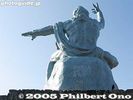
Rear view
|
|

Peace Statue description
|
|

Monument next to Peace Statue
|
|
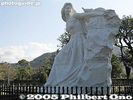
Peace memorial from ChinaThe park also has peace monuments from various countries.
|
|

Nagasaki atomic bomb peace park hypocenter
|
|

Peace memorial from Germany
|
|

Peace memorial from Czechoslovakia
|
|

Hypocenter of atomic bomb, adjacent to Peace parkAlmost right next to the Peace park is the hypocenter marker above which the bomb exploded. Often hoards of students on class trips can be see squatting here listening to a talk about this place.
|
|
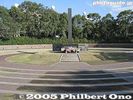
Hypocenter of atomic bombA series of concentric circles emanate from the marker.
|
|

Hypocenter markerOn August 9, 1945 an atomic bomb exploded in the sky about 500 meters above the point where this monument now stands. The area within a 2.5 kilometer radius of the hypocenter was completely devastated.
|
|

Hypocenter description
|
|

Remains of Urakami Cathedral wallNext to the hypocenter is this partial cathedral wall.
|
|
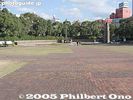
Hypocenter
|
|

Memorial at hypocenterErected in July 1995 for the 50th anniversary.
|
|

Nagasaki Atomic Bomb Museum. Next to the hypocenter is the atomic bomb museum and registry shelf which stores the names of the atomic bomb victims.
|
|

Registry Shelf storing the names of atomic bomb victims
|
|

The Registry Shelf points to the hypocenter.
|
|

Nagasaki Atomic Bomb Museum entrance
|
|
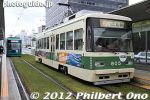
Street car stop nearest to the Hiroshima Peace Memorial Park. Hiroden Genbaku Dome-mae Station. Hiroshima is one of the few Japanese cities which still has street cars.
|
|
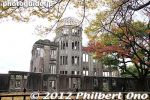
Right near the streetcar stop is the Atomic Bomb Dome or A-Bomb Dome (原爆ドーム). I visited in fall 2012.
|
|
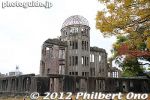
Built in 1915, it was the Hiroshima Prefectural Industrial Promotion Hall.
|
|
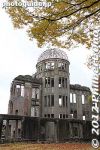
The atomic bomb fell almost directly above this building on Aug. 6, 1941 at 8:15 am.
|
|
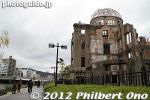
The Atomic Bomb Done was designated a UNESCO World Heritage Site in 1996.
|
|
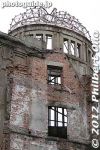
I think all Americans visiting or living in Japan should visit Hiroshima. It's not about who's to blame for what happened here in Aug. 1945. It's about a major event in human history and a reminder of man's fatal flaws.
|
|
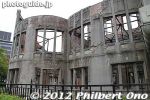
Notice the steel braces to reinforce the building.
|
|
|
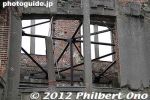
Notice the steel braces to reinforce the building.
|
|
|
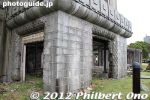
We can get quite close to the building, but it is fenced off so we cannot enter it.
|
|
|
|
|
|
|
|
|
|
|
|
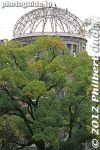
Hiroshima Atom Bomb Dome
|
|
|
|
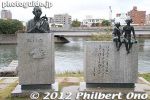
Monuments abound in the Peace Park. In the background is Aioi Bridge, the original target of the atomic bomb.
|
|
|
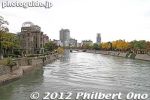
View from Aioi Bridge.
|
|
|
|
|
|
|
|
|
|
|
|
|
|
|
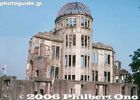
Atomic Bomb Dome
|
|
|
|
|
|
|
|
|
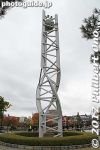
Peace Clock Tower
|
|

Peace Clock Tower
|
|
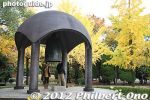
Peace Bell. Peace Bell. Anyone can ring it for free.
|
|

About the Peace Bell
|
|
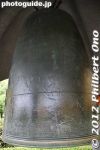
Hiroshima Peace Bell
|
|
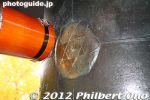
Hiroshima Peace Bell with atom symbol on the sweet spot.
|
|
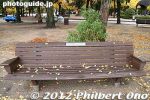
Donated benches.
|
|

Donors of benches.
|
|
|
|
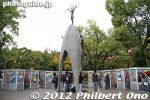
Children's Peace Monument dedicated to the memory of the children who died as a result of the bombing.
|
|
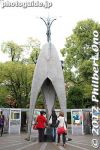
Children's Peace Monument
|
|

Children's Peace Monument before they built origami crane shacks around it.
|
|

Bell in Children's Peace Monument.
|
|
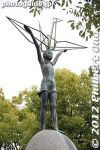
Children's Peace Monument, Hiroshima
|
|
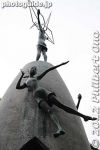
Rear of Children's Peace Monument, Hiroshima.
|
|

About the Children's Peace Monument.
|
|
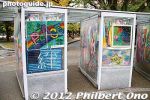
Shacks of origami paper cranes folded by many students from all over.
|
|

Very colorful and incredible designs.
|
|
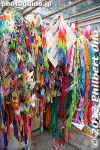
There's a sign indicating where you should hang your origami cranes.
|
|
|
|
|
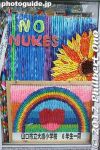
Hiroshima
|
|
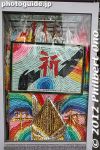
Pictures made of origami at Hiroshima Peace park.
|
|
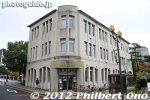
Another building that survived the atom bomb. Now a rest house and tourist information center. Hiroshima.
|
|

About the rest house.
|
|
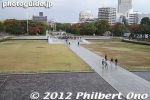
This is where the Hiroshima Peace Memorial Ceremony is held on Aug. 6 in the morning. The service is open to the public for free and you can sit if you get there early enough in the morning. Otherwise, you can stand in the back amid the sweltering heat.
|
|
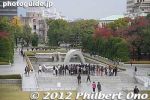
Memorial Cenotaph
|
|
|
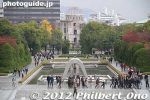
Memorial Cenotaph
|
|
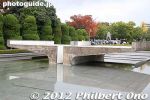
Peace Flame aligned with the Cenotaph and Atomic Bomb Dome.
|
|
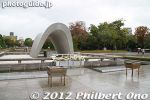
Memorial Cenotaph
|
|
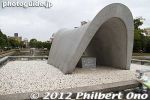
Memorial Cenotaph
|
|
|
|
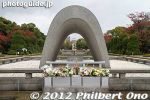
The Peace Park's focal point is this Memorial Cenotaph. It stores the names of all of the people killed by the bomb. The monument frames the Peace Flame and the A-Bomb Dome in a straight line.
|
|
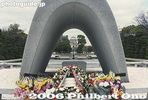
One of the Japan's best-designed memorials.
|
|
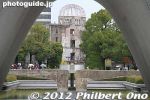
Atomic Bomb Dome as seen from the Cenotaph.
|
|
|
|
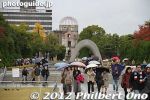
At least one blessing from the bomb is the endless stream of tourists coming to Hiroshima.
|
|

About the Hiroshima Peace Memorial Park.
|
|

Peace Flame and Hiroshima Peace Memorial Museum
|
|
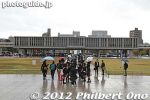
Hiroshima Peace Memorial Museum
|
|
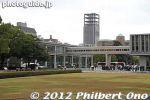
Hiroshima Peace Memorial Museum's East Wing built in 1994.
|
|
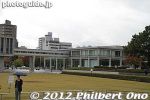
International Conference Center Hiroshima is also attached to the museum.
|
|
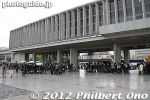
Main building of the Hiroshima Peace Memorial Museum with various exhibits explaining about the bombing and its effects. You also see many personal belongings mangled, melted, or tattered by the blast. Hordes of students on class trips from all over JapanHiroshima Peace Memorial Museum
|
|
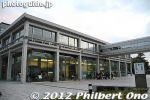
Hiroshima Peace Memorial Museum's East Wing built in 1994. You enter the museum through this building. Admission is only 50 yen for adults (30 yen for students).
|
|
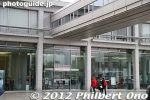
Entrance to Hiroshima Peace Memorial Museum through the East Wing. It has a lot of exhibits and can take a while to go through it if you want to read everything
|
|
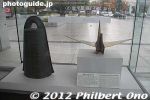
Original bell and origami sculpture for the Children's Peace Monument.
|
|
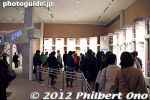
The East Wing explains the history of Hiroshima city before the bomb, development and decision to drop the bomb, the lives of Hiroshima citizens during World War II.
|
|
|
|
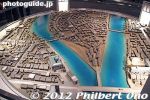
What central Hiroshima looked like before the bomb. The building that would become the Atomic Bomb Dome is on the lower left with the light green roof.
|
|
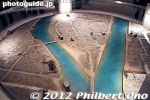
And how it looked after the bomb. The Peace Park is on the land in the center between the two rivers. The Atomic Bomb Dome is on the lower left.
|
|
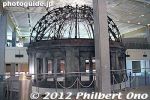
Scale model of the Atomic Bomb Dome.
|
|
|
|
|
|
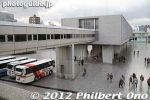
Corridor to the museum's main building or West Wing.
|
|
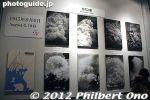
Photos of the atom bomb blast.
|
|
|
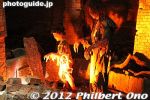
Mannequins depicting bomb victims who suffered peeling/melting skin among other things. This depiction has been toned down considerably from the original exhibit that I remember before the museum was renovated in 1994.
|
|
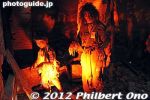
The original exhibit showed a much more horrific faces and disfigurement with peeling skin down to their knees at least. I heard that they didn't want to make it too scary for children. Too bad.
|
|
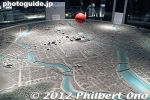
Orange ball shows where the bomb fell.
|
|
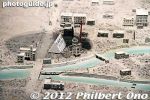
Atomic Bomb Dome area.
|
|
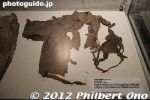
Tattered clothing from a 13-year-old girl who died in the evening on the day of the bomb.
|
|
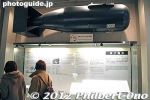
Life-size replica of the Hiroshima bomb, nicknamed "Little Boy." It's about 3 meters long.
|
|
|
|
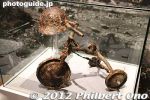
Tricycle
|
|

About the tricycle.
|
|
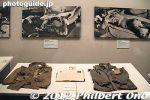
Grisly photos and tattered clothing.
|
|
|
|
|
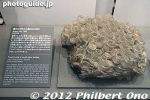
Glass bottles melted together.
|
|
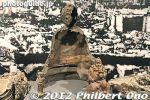
Damaged Buddha statue.
|
|
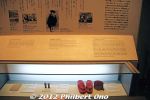
About Sadako.
|
|
|
|
|
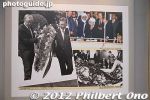
President Jimmy Carter visited Hiroshima after he left office.
|
|
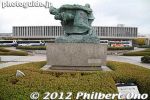
Front of the Hiroshima Peace Memorial Museum (opposite side from the Cenotaph) and Statue of Mother and Child in the Storm.
|
|
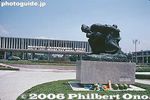
Atomic Bomb Museum and Statue of Mother and Child in the Storm.
|
|
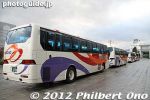
Many buses in front of the museum.
|
|
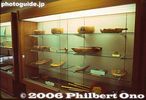
Showcase of gifts from Honolulu, Hawaii, Hiroshima's sister city.
|
|
|
|
|
|
|





































